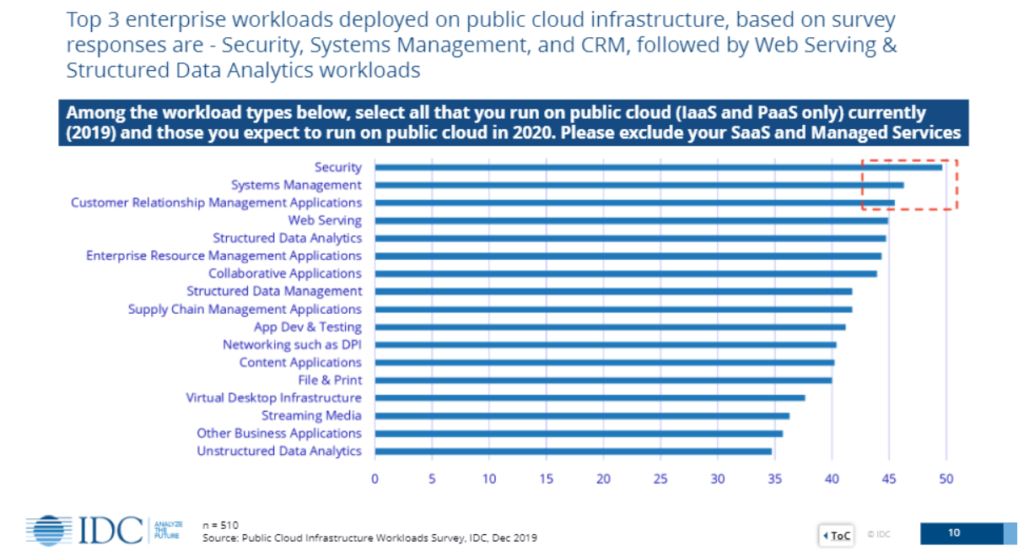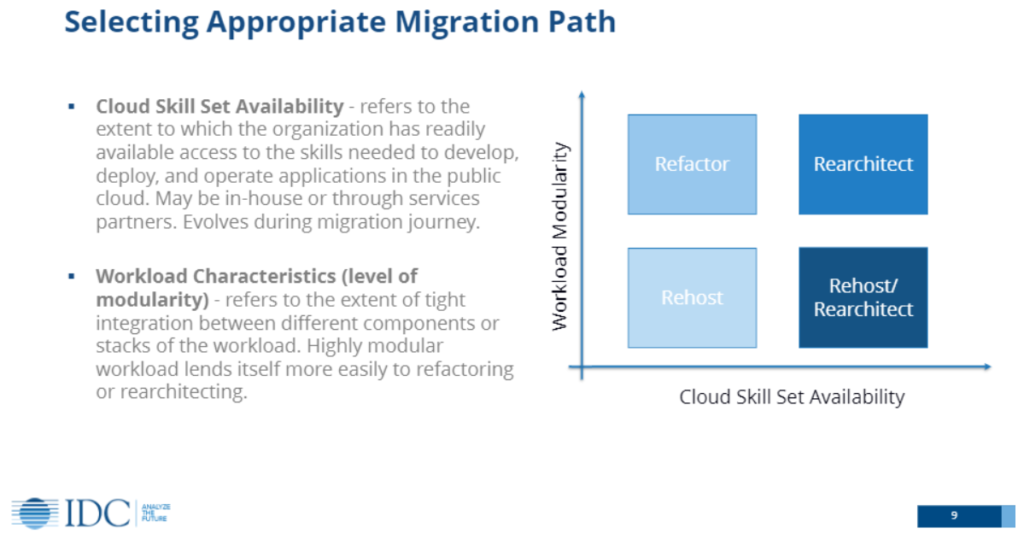Line of Business (LOB) applications or workloads determine the livelihood of enterprises and impact the success of enterprises directly. IDC tracks eighteen types of workloads across seven categories – Business Applications, Content and Collaboration, Data Management & Analytics, Engineering/ Technical, Application Development & Testing, IT Infrastructure, and Web Infrastructure. IDC Tracker products (Server Workloads, Enterprise Storage Workloads) track worldwide spend on infrastructure to power enterprise workloads across various deployment models, locations, and architecture types.
As enterprises are digitally transforming, their workloads are also getting transformed through modern technology innovations. They are also increasingly getting deployed outside of enterprise datacenters. This blog post summarizes key trends in enterprise workload transformations and provides recommendations to enable such workload transformations.
Key Trends
IDC observes following key trends among enterprise workloads – where they are getting deployed, how they are deployed, what their application architecture looks like, and how they are adopting technology innovations such as Artificial Intelligence/ Machine Learning.
Shift towards Cloud
As-a-Service consumption models enabled by cloud-based infrastructure provide enterprises with business agility and operational efficiency. Recent IDC research shows that enterprise spending on cloud-based infrastructure is increasing at a higher rate than the spend on traditional infrastructure. More enterprise workloads are getting deployed on cloud-based infrastructure. More specifically, CRM workloads are the largest workloads on cloud-based infrastructure and Structured Data Management workloads are the fastest growing workloads on cloud-based infrastructure.
Among Windows-based workloads, a majority of SCM and Data Management workloads are expected to be deployed on cloud-based infrastructure by 2023. IDC expects this trend to continue, with enterprise workloads increasingly finding a home on cloud-based infrastructure.
A recent IDC survey on enterprise workloads on public cloud infrastructure provides interesting insights into the nature of workloads on public cloud, primary drivers and inhibitors, and workload migration and repatriation patterns. AWS, Azure, and IBM Cloud are the top three cloud platforms being used by enterprise customers to deploy enterprise workloads. Among enterprise workloads, CRM, Web Server, and Structured Data Analytics are among the top workloads deployed on public cloud infrastructure.
Survey responses show that the most common size of enterprise workloads running on public cloud infrastructure being 1-9 VMs (Compute) and 50-99TB (Virtual Storage), displaying an opportunity to scale. More than 40% of the respondents classified their usage of public cloud as ‘Production’ use case. Lift and Shift migration path dominates enterprise workload migration to the public cloud, with respondents indicating it to be the most common migration path for almost all types of enterprise workloads. Top workloads to be repatriated to on-premises infrastructure include Security, App Dev & Testing, and System Management, with primary drivers for repatriation cited being resource consolidation, data security concerns, and better TCO.

Workload Transformations
Technology innovations, such as cloud-native design, microservices, and AI/ ML technologies enable enterprises to enhance their business applications by enabling new use cases, improving developer productivity, or improving user experience. AI innovations, such as Computer Vision, being available on edge locations and smaller form factors are enabling newer use cases facilitating IT/OT convergence for certain verticals such as Manufacturing and Energy. Cloud-native design processes are enabling unprecedented developer productivity, thereby enabling enterprises to bring product innovations to market sooner.
IDC expects enterprise workloads to go through radical transformations by adopting such technology innovations. IDC predicts that by 2024, AI will be a core component of enterprise workloads with 20% of enterprise workloads to be AI-based or AI-enabled for 75% of enterprises. IDC also estimates that in the next five years more than 500 Million new business applications to be developed using No-Code or Low-Code application development techniques. Such trends are expected to continue, with workload transformations constituting a key component of infrastructure modernization.
Recommendations
Start with Business Goals
IDC recommends approaching technology innovations as means, not as ends. Often, customers tend to start with a technology innovation (for example, Kubernetes) rather than a business goal (for example, release new product features in 3 weeks). This could result in higher costs, decreased productivity, disappointment, or even disillusionment. A recent IDC survey shows that more than 50% of AI initiatives among enterprises failed due to a lack of organization-wide AI strategy. To avoid disappointments like this, start from your business goal and select the right technology that can enable the business goal.
Lead with Workloads
IDC recommends taking a workload centric approach to cloud migration and application modernization. When you are migrating your workloads to public cloud infrastructure, identify the appropriate migration path based on workload characteristics and cloud expertise available. As you mature in your cloud migration journey, be open and revisit migration paths as required.

Right Infrastructure for Right Workload
With enterprises being at various levels of technology/ cloud adoption maturity and enterprise workloads going through transformations, one platform may not satisfy all business requirements. Enterprises are recognizing the reality of hybrid cloud to leverage capabilities available across cloud, core, and edge locations.
IDC recommends selecting the right location and infrastructure for the workload based on workload characteristics. For example, public cloud IaaS enables workloads that need to scale and workloads that need to leverage higher-order cloud-based services; specialized/ accelerated hardware is better suited for AI/ ML workloads, and high-density servers may be suitable for HPC workloads. Similarly, OT workloads that need immediate decisions can be better served at edge locations, while IT workloads that need historic analysis may be better served at cloud or core.
As enterprises are going through digital transformations, workload migrations and transformations play a significant role in their journey of transformation. IDC’s research on infrastructure for workloads tracks such transformations and provides actional insights on infrastructure choices to technology vendors and enterprise users. For such actionable insights and recommendations, please check our CIS: Infrastructure for Workloads: Trends and Strategies.




